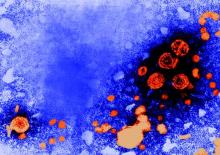Hepatitis B vertical infections are rare, but they are more likely if any of several risk factors are present, according to the results of a study led by Dr. Sarah Schillie.
Dr. Schillie of the division of viral hepatitis at the Centers for Disease Control and Prevention, Atlanta, and her associates analyzed prospectively collected data from 2007 to 2013 on 17,951 infant-mother pairs (including 15,938 mothers) in five U.S.-funded Perinatal Hepatitis B Prevention Programs in Florida, Michigan, Minnesota, New York, and most of Texas. The mothers had a median age of 30 years, and all tested positive for hepatitis B surface antigen (HBsAg).
Most infants born to mothers with active hepatitis B virus (HBV) received the vaccine plus immune globulin, but 1.1% acquired the infection perinatally (Pediatrics 2014 April 20 [doi:10.1542/peds.2014-3213]).
Newborns were more likely to acquire an infection if their mother was younger, was of Asian or Pacific Islander race, tested positive for hepatitis B antigens, tested negative for antibodies to hepatitis B antigens, or had a viral load of at least 2,000 IU/mL.
Further, 6.7% of infants with fewer than three doses of the vaccine developed an HBV infection, compared with 1.1% of infants who received at least three doses. Developing an infection was not linked to gestational age, birth weight, or timing of the vaccine or immune globulin (within or after 12 hours of birth).
“The identification of women with a higher risk of perinatal hepatitis B transmission in the context of optimal postexposure prophylaxis suggests that interventions such as maternal antiviral therapy might further decrease or eliminate perinatal hepatitis B infections,” Dr. Schillie and her associates reported.
Among 11,479 infants with information on HBV vaccine timing, 96.4% received the vaccine within 12 hours of birth; 95.5% of 11,633 newborns with timing data received hepatitis B immune globulin. Among 11,335 newborns with information available, 94.9% received both. HBsAg results were available for 51.5% of the total group (9,252 infants): 99.5% of these received at least three doses of the vaccine, and 1.1% (100 infants) acquired HBV perinatal infections.
The research was funded by the CDC and the U.S. Department of Energy. The authors reported no disclosures.


